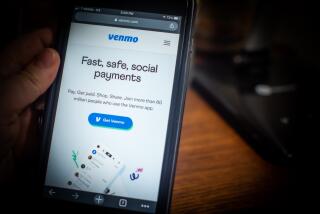Debit Cards Offer Ease, but Carry Some Risks and Disadvantages
- Share via
Question: For several years I have enjoyed the convenience of a Visa debit card. At the end of the month I know exactly what purchases I’ve made. Now, however, I understand that fraudulent purchases on a debit card are not covered. In fact, someone with access to my card and personal identification number could drain the account. With me living on Social Security and the amount of money that goes through this account on a monthly basis, I am very worried as the loss would be disastrous. Am I worried for no reason, or do you have any suggestions as to what I should do to protect myself?
Answer: You didn’t get the whole story.
It’s true that by law, your bank could make you liable for fraudulent purchases. But the banking industry realized what a huge impediment that would be to debit card use, so most issuers limit your liability to $50 or less.
Visa USA, in particular, says its “zero-liability” policy applies to its debit cards as well as credit cards. In other words, if someone steals from your account, you will be made whole, whether the transaction occurred using your credit card or your debit card. Visa waives the $50 liability fee.
The problem is, of course, that if someone uses your debit card to drain your checking account, the money is gone for the time it will take for your claim to be investigated and your account to be reimbursed. By contrast, if there are fraudulent charges on your credit card, you simply wouldn’t pay them.
Some people use that risk as a reason not to use a debit card. Others are so sold on debit cards’ convenience that they would never give them up.
As you’ve found, the biggest advantage of debit cards is the detailed record you get of your spending. Debit card transactions show you exactly where you spent your money and when. It can be much harder to keep an accurate record of your purchases if all you have are check numbers on your bank statement or receipts for ATM cash withdrawals.
You also don’t have to worry about spending more than you can afford. Since the money comes directly from your checking account, you can’t spend what you don’t have. Recovering shop-aholics have found debit cards to be an invaluable tool in learning how to properly manage money.
If you want to continue using your debit card, you can protect yourself by treating your card as if it were cash. Keep it in your wallet or within your sight at all times. Don’t give it to a waiter or anyone else who can disappear with it for a few seconds; that’s all the time it takes a thief to use a pocket-size device to “skim” the information from the magnetic strip on the back.
The thief doesn’t need your personal identification number to steal money from your account. Many merchants accept debit cards as if they were credit cards, so all the miscreant has to do is scrawl a name on a signature line to buy what he wants.
If your wallet or card is stolen, call your bank immediately so it can cancel the card. You should keep a list of all your debit and credit card numbers, along with the issuing banks’ emergency phone numbers, in a safe place for just such an occasion.
Also, make sure you have enough cash in another account to cover any short-term emergencies. The amount should equal at least a month’s worth of expenses, and preferably three to six months’ worth. Such an emergency fund is a smart idea in any case, but particularly if you might have to subsist awhile without the money in your checking account.
You probably also don’t want to use your debit card for large purchases or other transactions in which you may need some negotiating leverage. Federal law gives you the right to withhold payment on defective items or services purchased with a credit card, if you’ve made a good-faith effort to resolve the dispute with the merchant. Debit cards don’t offer the same protection.
Contributions for 457, 401(k) Plans
Question: I work for a government agency and have many excellent benefits, including a pension plan and a 457 plan. But why is there an $8,500 maximum that I can contribute to the 457 plan, while my husband is allowed a maximum contribution of $10,500 under his 401(k) plan?
Answer: There’s probably some long-winded explanation for the difference, but fortunately Congress has made the point moot.
The tax-relief bill that passed this year raises maximum contributions for both 401(k) plans and 457 plans to $11,000 next year. People 50 and older will be allowed to contribute an additional $1,000 to these company-sponsored retirement plans.
*
Liz Pulliam Weston is a personal finance writer for The Times and a graduate of the personal financial planning certificate program at UC Irvine. Questions can be sent to her at moneytalk@la times.com or mailed to her in care of Money Talk, Business Section, Los Angeles Times, 202 W. 1st St., Los Angeles, CA 90012. She regrets that she cannot respond personally to queries. For past Money Talk questions and answers, visit The Times’ Web site at https://www.la times.com/moneytalk.
More to Read
Inside the business of entertainment
The Wide Shot brings you news, analysis and insights on everything from streaming wars to production — and what it all means for the future.
You may occasionally receive promotional content from the Los Angeles Times.










